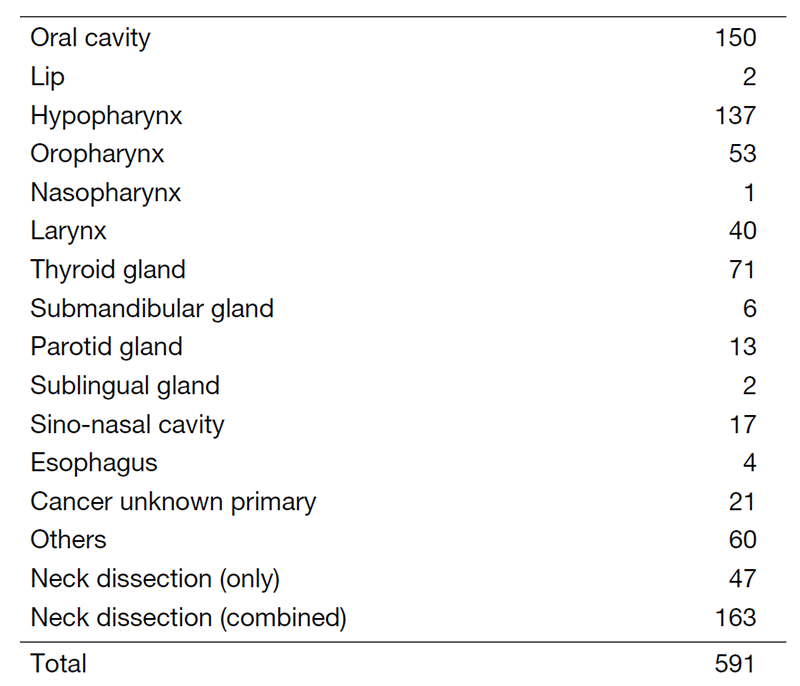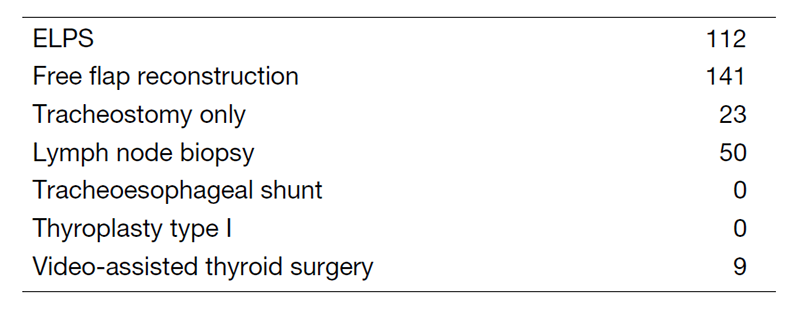Annual Report 2020
Department of Head and Neck Surgery
Kazuto Matsuura, Takeshi Shinozaki, Toshifumi Tomioka, Wataru Okano, Yohei Morishita, Ryuichi Hayashi, Masao Adachi, Yusuke Itoh, Masanobu Sato, Shohei Fujimoto, Yuki Takaoka
Introduction
Our specialty is function-preserving surgery. We have been working on improving prognosis and developing surgical techniques that preserve vocal and swallowing functions. Typical surgical procedures include laryngeal preservation surgery for T1/T2 recurrent glottic cancer after radiation therapy and laryngeal preservation surgery for hypopharyngeal cancer. We have also developed a method for trans-oral resection of pharyngeal cancer without cutting the lower lip or lower jaw, and developed conservative neck dissection. As a result of these efforts, in radical surgery for laryngeal and hypopharyngeal cancer, there are many cases in which voice is preserved compared with other facilities. In recent years, the number of cases of transoral resection using an endoscope for early-stage laryngo-pharyngeal cancer has increased, and minimally invasive surgery has become widespread in our department.
The Team and What We Do
Multimodal therapy is the current treatment policy for head and neck cancer. For the effective implementation of available therapeutic modalities, six staff surgeons at our department work closely with plastic surgeons, radiotherapists, medical oncologists, pathologists, dentists, psycho-oncologists, and nurses. To facilitate regular communication among the members of this large team, several weekly conferences are conducted. From April 2020 to March 2021, 591 operations were performed. A total of 112 cases underwent endoscopic laryngo-pharyngeal surgery (ELPS), 141 cases underwent free flap reconstruction, and 9 cases underwent endoscopic thyroid surgery (Tables 1 and 2).
Table 1. Number of patients (April 2020 to March 2021)

Table 2. Type of procedures (April 2020 to March 2021)

Research activities
The following research themes were established: (1) Development of equipment for head and neck endoscopic surgery (2) Creation and analysis of a head and neck cancer database (3) Development of supportive care for head and neck cancer surgery. In (1), the development of forceps for endoscopic surgery and hemostatic clip appliers was promoted. In (2), the data of approximately 6000 patients undergoing head and neck cancer surgery were templated and a database was created. Using this information, we analyzed the long-term prognosis of patients with laryngeal-preservation surgery for elderly patients with head and neck cancer. In (3), a multicenter joint study of an enhanced recovery after surgery (ERAS) program for head and neck cancer reconstructive surgery was launched and became a J-SUPPORT-approved study (PreSte-HN study: J-SUPPORT 2002).
Clinical trials
As a clinical trial, a study on the development of diagnostic and therapeutic methods for superficial head and neck cancer based on the AMED Hayashi team (18ck0106226h0003) "National registry of superficial head and neck cancer" was advanced. Phase III study of the "TOS-J trial (Research representative: Ryuichi Hayashi, Phase II/III study of transoral surgery for superficial head and neck cancer in Japan)" was started in August 2018. Furthermore, two studies in the JCOG Head and Neck Cancer Group (Group Leader: Ryuichi Hayashi) also made progress. JCOG1212 (Dose finding and confirmatory trial of superselective intraarterial infusion of cisplatin and concomitant radiotherapy for patients with locally advanced maxillary sinus cancer) is also underway. A number of cases were also enrolled in JCOG1601 (Randomized phase III study to evaluate the value of omission of prophylactic neck dissection for stage I/II tongue cancer).
Education
The head and neck cancer specialist system was launched in 2009, and in 2020, we accepted training for one cancer specialist. Hospital visits and training were restricted due to the spread of coronavirus infection. The number of visitors from Japan was three doctors and three medical students. Our hospital has been a training facility for fellowship programs of the Japan Society for Head and Neck Cancer since 2014, but did not accept trainees from overseas in 2020.
Future Prospects
Head and neck cancer treatment has entered a new era of multidisciplinary treatment, recognizing the importance of supportive care for the completion of treatment, along with the improvement of surgical techniques, technological innovation of radiotherapy, and the development of drug therapy. In addition, the number of elderly patients with head and neck cancer is increasing, which has become a major issue in medical care. We have built a smooth cooperation system between related clinical departments, but we intend to construct telemedicine in the future. As a surgical technique, we intend to promote the development of minimally invasive, function-preserving treatments such as oral resection.
List of papers published in 2020
Journal
1. Okano W, Hayashi R, Matsuura K, Shinozaki T, Tomioka T. Extent of salvage neck dissection following chemoradiation for locally advanced head and neck cancer. Head Neck. 2021 (43):413-418.
2. Tsushima N, Shinozaki T, Fujisawa T, Tomioka T, Okano W, Ikeda M, Tahara M, Higashino T, Hayashi R.. Salvage Reconstructive Surgery During Nivolumab Therapy for a Patient With Hypopharyngeal Cancer. Clin Med Insights Case Rep. 2020; 13: 1179547620908854.
3. Shinozaki T, Katada C, Shiga K, Asakage T, Yokoyama T, Yano T, Oda I, Shimizu Y, Takemura K, Ishikawa H, Yokoyama A, Muto M. Effectiveness of planned surveillance for detecting second primary head and neck cancers after endoscopic resection of esophageal squamous cell carcinoma. Jpn J Clin Oncol. 2020 (50):1162-1167.
4. Tomioka T, Yano T, Fujii S, Matsuura K and Hayashi R. A Case with Laryngeal Cartilage Necrosis after Trans Oral Surgery for Superficial Squamous Cell Carcinoma. Surgical Case Reports doi: 10.31487/j.SCR.2020.10.13
5. Shiga K, Nibu KI, Fujimoto Y, Asakage T, Homma A, Mitani H, Ogawa T, Okami K, Murono S, Hirano S, Ueda T, Hanai N, Tsukahara K, Ota I, Yoshimoto S, Shinozaki T, Iwae S, Katagiri K, Saito D, Kiyota N, Tahara M, Takahashi F, Hayashi R. Multi-institutional Survey of Squamous Cell Carcinoma of the External Auditory Canal in Japan. Laryngoscope, 131:E870-E874, 2021
6. Imai T, Sato Y, Abe J, Kumagai J, Morita S, Saijo S, Yamazaki T, Asada Y, Matsuura K. Shoulder function after neck dissection: Assessment via a shoulder-specific quality-of-life questionnaire and active shoulder abduction. Auris Nasus Larynx, 48:138-147, 2021
7. Saijoh S, Nakamura-Shima M, Shibuya-Takahashi R, Ito R, Sugawara A, Yamazaki T, Imai T, Asada Y, Matsuura K, Iwai W, Wakui Y, Abue M, Kawamura S, Katayose Y, Fujimori H, Mochizuki M, Yasuda J, Yamaguchi K, Sugamura K, Satoh K, Katori Y, Tamai K. Discovery of a chemical compound that suppresses expression of BEX2, a dormant cancer stem cell-related protein. Biochem Biophys Res Commun, 537:132-139, 2021
8. Imai T, Kurosawa K, Asada Y, Momma Y, Takahashi M, Satake N, Azuma M, Suzuki A, Sasaki M, Morita S, Saijo S, Fujii K, Kishimoto K, Yamazaki T, Goto T, Matsuura K. Enhanced recovery after surgery program involving preoperative dexamethasone administration for head and neck surgery with free tissue transfer reconstruction: Single-center prospective observational study. Surg Oncol, 34:197-205, 2020
